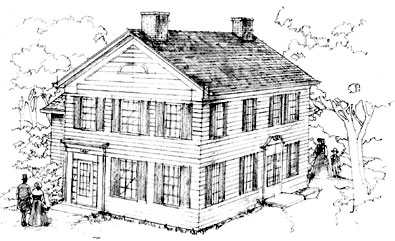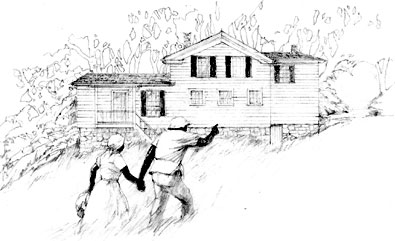
The Lathrop House
Preserving the Past to Enrich the Future

The stately Greek revival home known as the Lathrop House was the residence of Lucian Lathrop, an ordained minister of the Universalist Church. A proud descendant of generations of abolitionists, Lathrop served as an elected State Representative in the Ohio Legislature. At the same time, he engaged in the outlawed activities of the Underground Railroad.
The Lathrop House was one of many locations which were scattered throughout the State of Ohio where men, women and children fleeing slavery found shelter and safety. Harboring runaway slaves was illegal in America after the passage of the Fugitive Slave Act of 1850. Despite harsh consequences, abolitionists continued to assist slaves in making their way to freedom. “Conductors” directed the escapees to the next safe house, barn, or business as the fugitive slaves continued their harrowing journey ever northward.
Upon the conclusion of the Civil War and the adoption of the Thirteenth Amendment to the Constitution, the Underground Railroad faded into history. After Lathrop’s time, his residence continued to serve as a private home for many civic leaders of Sylvania and Northwest Ohio. The house attained recognition not only for its role in American history, but also as the oldest home in Sylvania, Ohio, having originally been built in 1835. In the fall of 2001, the house was sold to a new owner and slated for demolition.
Organizing as a grass roots group, the Friends of the Lathrop House rallied the greater Toledo community to preserve this important piece of American history. City and township governments, businesses, organizations, and individuals throughout Northwest Ohio and as far away as South Carolina contributed to the cause.
In the summer of 2004, the Lathrop House was moved not far from its original site to Sylvania’s Harroun Park in order to be preserved. Its new location places it on the same ravine system that fleeing slaves used as they traversed the woods from the Harroun Barn, another station on the route, to the Lathrop House.
The Friends of the Lathrop House and the Metroparks of the Toledo Area are working hand in hand to preserve the Lathrop House as a stop on the Underground Railroad, and to provide educational programming to bring this pivotal time in our nation’s history to life.
The estimated cost of renovating the Lathrop House is nearly 1.5 million dollars. Of that, more than $345,000 has already been raised to fund Phase I, the restoration of the exterior of the house to its mid-nineteenth century appearance.
The Friends are now engaged in fundraising for Phase II, which includes the rebuilding of the basement, where escaping slaves sought shelter, using the original foundation stones which were salvaged when the house was moved. The estimated cost for this construction, which includes all mechanical systems and a barrier-free entrance, is approximately $280,000.
The completion of Phase II will mark the first time that the general public will have access to the Lathrop House. With this milestone, the house will become the only Underground Railroad station in northwest Ohio open to all.
As a safe haven for those seeking freedom, the Lathrop House truly represented the brightest of lights in the darkest of times. Its presence in our community bears witness to a simple truth that resonates as deeply today as it did one hundred fifty years ago: our greatest strides are made when, arm in arm, we make them together.




